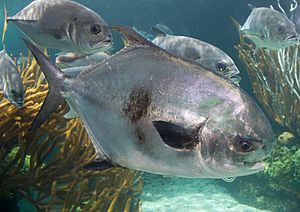Permit (fish) facts for kids
Quick facts for kids Permit |
|
|---|---|
 |
|
| Conservation status | |
| Scientific classification | |
| Synonyms | |
|
Labrus falcatus Linnaeus, 1758 |
The permit (Trachinotus falcatus) is a type of fish popular for sport fishing. It lives in the western Atlantic Ocean and belongs to the family called Carangidae, also known as the jack family. Adult permits enjoy eating crabs, shrimp, and smaller fish.
Contents
What is a Permit Fish?
How Was the Permit Fish Discovered?
The permit fish was first described by a famous scientist named Carl Linnaeus in 1758. He is often called the "father of taxonomy" because he created the system we use to name and classify living things. He wrote about the permit in his book Systema Naturae, which was the tenth edition.
Linnaeus first named this fish Labrus falcatus. Later, scientists decided it fit better in a different group, or genus, called Trachinotus. The permit is the main example, or type species, for the Trachinotus genus.
What Does the Name "Permit" Mean?
The scientific name for the permit fish tells us a bit about it! The genus name, Trachinotus, comes from two ancient Greek words. Trachys means "rough," and noton means "back."
The species name, falcatus, comes from a Latin word. It means "armed with scythes." This is a cool reference to the permit's dorsal fin, which is on its back. Sometimes, when groups of permit fish are feeding near the water's surface, this fin sticks out, looking a bit like a scythe!
Permit Fish Body and Appearance
Permit fish have special features that help you tell them apart. They have long dorsal fins (on their back) and anal fins (on their belly). The dorsal fin is shaped like a scythe, which is a curved blade. Their tails are also deeply forked, like a "V" shape.
Their bodies are flat from side to side, which means they look tall and thin if you see them from the front.
What Are the Permit's Fins Like?
A typical permit fish has six or seven stiff spines in its dorsal fin, followed by 18 to 20 soft rays. The anal fin has two or three spines and 16 to 18 soft rays. Both the dorsal and anal fins have dark, rounded parts at the front.
Permits do not have scutes, which are bony plates found on some fish. They have a large, orange-yellow spot on their belly, right in front of their anal fins. Their pectoral fins, which are on their sides, are dark.
How Big Can a Permit Fish Get?
Permit fish can grow quite large! The Florida Museum of Natural History reports that they can reach a maximum length of 48 inches (about 122 centimeters). They can also weigh up to 79 pounds (about 36 kilograms). That's a big fish!
Where Do Permit Fish Live?
Permit Fish Habitat
Permit fish usually live in shallow, warm waters. You can find them in places like mudflats, channels, and areas with muddy bottoms.
Even though they live close to shore and sometimes in brackish areas (where fresh and saltwater mix), permit fish travel offshore to lay their eggs. Young permit fish are often found in the surf zone, which is where waves break on the beach. This area has lots of small invertebrates for them to eat.
Where Can You Find Permit Fish?
Permit fish are found in the western part of the Atlantic Ocean. Their range stretches from Massachusetts in the United States all the way down to Brazil in South America. They also live around most of the beautiful Caribbean islands.
Interestingly, two submarines of the United States Navy were named USS Permit in honor of this fish. This was part of a tradition of naming submarines after "denizens of the deep" (creatures of the ocean).
Images for kids
-
A permit caught off the coast of Nicaragua
-
Another, near seagrass in the Florida Keys
-
A wild permit off the coast of Belize
See also
 In Spanish: Trachinotus falcatus para niños
In Spanish: Trachinotus falcatus para niños







